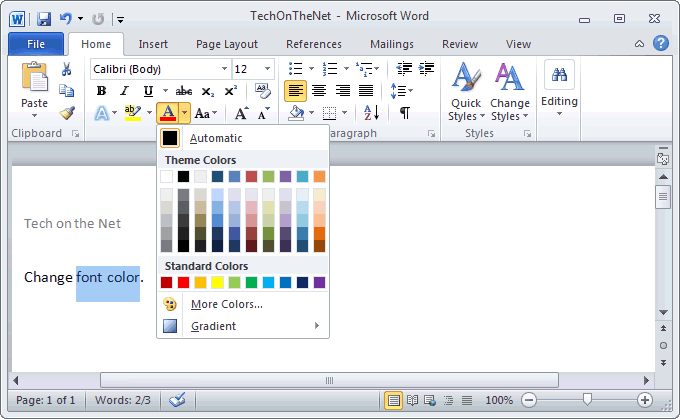Exploring the Spectrum: A Comprehensive Guide to Changing Text Color in Microsoft Word

In the vibrant canvas of Microsoft Word, text color serves as a dynamic element that adds depth, emphasis, and visual appeal to your documents. Whether you’re crafting a professional report, designing a creative flyer, or composing a captivating presentation, knowing how to manipulate text color effectively is essential for conveying your message with clarity and impact. In this extensive guide, we’ll delve into the intricacies of changing text color in Microsoft Word, empowering you to unleash your creativity and enhance the aesthetic quality of your documents with confidence and finesse.
Understanding the Significance of Text Color:
Before diving into the practical aspects of changing text color, it’s crucial to recognize the significance of color in written communication. Color can evoke emotions, convey meaning, and highlight important information within your document. By strategically selecting text colors, you can capture your audience’s attention, emphasize key points, and create a visually engaging experience. Whether you’re using bold hues to make headings pop or subtle shades to differentiate text elements, understanding the impact of color is essential for effective document design.
Basic Text Color Modification:
Changing text color in Microsoft Word is a fundamental skill that can be accomplished using intuitive tools and commands. Here’s how to do it:
- Select the Text:
- Begin by selecting the text whose color you wish to change. You can do this by clicking and dragging your cursor over the text or by placing your cursor at the beginning of the text and holding down the mouse button while dragging to the end of the desired selection.
- Access the Font Color Menu:
- With the text selected, navigate to the “Home” tab located in the top menu bar of Microsoft Word.
- In the “Font” group, you’ll find the “Font Color” button, represented by an icon depicting the letter “A” with a colored bar underneath. Click on this button to access the font color menu.
- Choose a Text Color:
- Upon clicking the “Font Color” button, a dropdown menu will appear, displaying a palette of color options. Hover your cursor over each color to preview it in real-time.
- Select the desired text color by clicking on it. The selected text will immediately change to the chosen color.
Advanced Text Color Customization:
While the basic text color modification method is straightforward, Microsoft Word offers advanced customization options to fine-tune your text color choices and create visually stunning documents. Here are some additional features you may explore:
- More Colors:
- If the default color palette doesn’t offer the exact shade you’re looking for, Word provides the option to access additional colors. Simply click on “More Colors” at the bottom of the font color menu to open a dialog box where you can choose from a spectrum of colors or enter specific RGB or HSL values.
- Custom Text Highlight Colors:
- In addition to changing text color, Word allows users to customize text highlight colors for added emphasis. To highlight text with a custom color, select the text, click on the “Text Highlight Color” button (located next to the font color button), and choose a highlight color from the dropdown menu.
- Theme Colors:
- Word’s theme colors feature enables users to maintain consistency and coherence in document design by applying colors from the current theme. To use theme colors for text, select the text, click on the “Font Color” button, and choose one of the theme colors from the dropdown menu.
Best Practices for Text Color Usage:
While text color offers versatility and creativity in document design, it’s essential to use it judiciously and in accordance with best practices. Here are some tips to consider:
- Ensure Readability:
- Choose text colors that provide sufficient contrast against the background color or texture to ensure readability, especially for users with visual impairments. High-contrast combinations, such as black text on a white background, are generally recommended for optimal readability.
- Use Color with Purpose:
- Select text colors strategically to convey meaning, emphasize key points, or differentiate between text elements. Avoid using color indiscriminately, as it may confuse or distract readers if not used purposefully.
- Test Across Devices:
- When using custom text colors or highlighting, test your document across different devices and display settings to ensure that the colors appear as intended. Variations in screen calibration or device settings may affect color accuracy.
Conclusion:
Changing text color in Microsoft Word is a powerful tool that allows users to enhance the visual appeal, readability, and impact of their documents. By mastering the basic modification process, exploring advanced customization options, and adhering to best practices for text color usage, you can create documents that captivate your audience and effectively convey your message. Whether you’re designing reports, presentations, marketing materials, or creative projects, text color offers versatility and flexibility to elevate your document’s aesthetic quality and communicative effectiveness. So, the next time you embark on a document creation journey in Word, remember to leverage the power of text color to transform your writing into a visual masterpiece that resonates with your audience.




